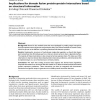78 search results - page 4 / 16 » An integrated system for studying residue coevolution in pro... |
BMCBI
2007
13 years 7 months ago
2007
Background: The recent increase in the use of high-throughput two-hybrid analysis has generated large quantities of data on protein interactions. Specifically, the availability of...
BMCBI
2008
13 years 7 months ago
2008
: The tumour suppressor protein p53 protein has a core domain that binds DNA and is the site for most oncogenic mutations. This domain is quite unstable compared to its homologs p...
NAR
2000
13 years 7 months ago
2000
The ASTRAL compendium provides several databases and tools to aid in the analysis of protein structures, particularly through the use of their sequences. The SPACI scores included...
EUROSYS
2010
ACM
14 years 25 days ago
2010
ACM
A complex software system typically has a large number of objects in the memory, holding references to each other to implement an object model. Deciding when the objects should be...
BMCBI
2004
13 years 7 months ago
2004
Background: Several in silico methods exist that were developed to predict protein interactions from the copious amount of genomic and proteomic data. One of these methods is Doma...

